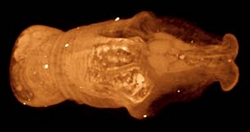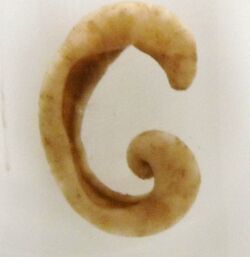Biology:Aplacophora
| Aplacophora | |
|---|---|

| |
| Head region of the caudofoveate Falcidens | |
| Scientific classification | |
| Domain: | Eukaryota |
| Kingdom: | Animalia |
| Phylum: | Mollusca |
| Class: | Aplacophora |
| Included groups | |
| |
Aplacophora /æpləˈkɒfərə/ is a presumably paraphyletic taxon. This is a class of small, deep-water, exclusively benthic, marine molluscs found in all oceans of the world. [1]
All known modern forms are shell-less: only some extinct primitive forms possessed valves. The group comprises the two clades Solenogastres (Neomeniomorpha) and Caudofoveata (Chaetodermomorpha), which between them contain 28 families and about 320 species. The aplacophorans are traditionally considered ancestral to the other mollusc classes. However, the relationship between the two aplacophoran groups and to the other molluscan classes and to each other is as yet unclear.
Aplacophorans are cylindrical and worm-like in form, and most very small, being no longer than 5 centimetres (2 in); some species, however, can reach a length of 30 centimetres (12 in).
Habitat
Caudofoveates generally burrow into the substrate while solenogasters are usually epibenthic. Both taxa are most common in water regions deeper than 20 metres (66 ft) where some species may reach densities up to four or five specimens per square metre (three or four per square yard). Solenogasters are typically carnivores feeding on cnidarians or sometimes annelids or other taxa while caudofoveates are mostly detritovores or feed on foraminiferans.[2]
Description
Aplacophorans are worm-like animals, with little resemblance to most other molluscs. They have no shell, although small calcified spicules are embedded in the skin; these spicules are occasionally coated with an organic pellicle that is presumably secreted by microvilli.[3] Caudofoveates lack a foot while solenogasters have a narrow foot which lacks intrinsic musculature. The mantle cavity is reduced into a simple cloaca, into which the anus and excretory organs empty, and is located at the posterior of the animal. The head is rudimentary, and has no eyes or tentacles.[4] The cuticle of both subclasses is chitinous,[5] and has an irregular texture.[6] Spines bear an organic matrix.[7] Sclerites can be hollow or solid; the void within the sclerites of some species fills during growth.[6] Sclerites generally form within the cuticle, protruding through when they are fully grown.[6] They probably start life as amorphous calcium carbonate, which the organic matrix coaxes into an aragonitic habit as the spines mature.[6] Sclerites can be shaped as simple spines, straight, curved, keeled, striated or hooked; or as cupped blades; more complex arrangements are common in copulatory spicules.[8][9] In several species of solenogaster, sclerites change morphology during growth; young specimens might bear flat, solid, scale-like sclerites, to be replaced with longer hollow spine-like sclerites in adults.[10]
The relationship with other molluscs, however, is apparent from some features of the digestive system; aplacophorans possess both a radula and a style. A variety of radular forms and functions exist.[11] Solenogasters are hermaphroditic and assumed to have internal fertilization, in contrast to caudofoveates which have two sexes, and reproduce by external fertilization. During development, the mantle cavity of the larva curls up and closes, creating the worm-like form of the adult.[4] Caudofoveates also differ from Solenogasters in having a head shield and a body that is differentiated into three sections.[12]
Taxonomy and evolution
This class was once classified as sea cucumbers in the echinoderms. In 1987, they were officially recognized as molluscs and given their own class. It consists of two clades: the Solenogastres and the Caudofoveata. It has been considered polyphyletic[13] but more recent molecular evidence supports it as a monophyletic clade.[14][15]
The affinities of Aplacophorans have long been uncertain. Molecular and fossil evidence seemed to put Aplacophorans in the clade Aculifera, as a sister group to Polyplacophora.[14][15][16][17][18] The discovery of Kulindroplax in 2012, a fossil aplacophoran with a polyplacophoran-like armour, strongly supports this hypothesis, and shows that aplacophorans evolved from progenitors that bore valves.[19]
References
- ↑ MolluscaBase eds. (2021). MolluscaBase. Aplacophora. Accessed through: World Register of Marine Species at: http://www.marinespecies.org/aphia.php?p=taxdetails&id=411 on 2021-04-13
- ↑ Todt, C. (2013). "Aplacophoran Mollusks—Still Obscure and Difficult?". American Malacological Bulletin 31: 181–187. doi:10.4003/006.031.0110.
- ↑ Haas, Winfried (1981). "Evolution of calcareous hardparts in primitive molluscs". Malacologia 21: 403–418. https://archive.org/stream/malacologia211981inst/malacologia211981inst_djvu.txt.
- ↑ 4.0 4.1 Barnes, Robert D. (1982). Invertebrate Zoology. Philadelphia, PA: Holt-Saunders International. p. 389. ISBN 978-0-03-056747-6.
- ↑ Peters, W. (1972). "Occurrence of chitin in mollusca". Comparative Biochemistry and Physiology B 41 (3): 541–550. doi:10.1016/0305-0491(72)90117-4.
- ↑ 6.0 6.1 6.2 6.3 Kingsley, Roni J.; Froelich, Jenna; Marks, Carolyn B.; Spicer, Lori M.; Todt, Christiane (2012). "Formation and morphology of epidermal sclerites from a deep-sea hydrothermal vent solenogaster (Helicoradomenia sp., Solenogastres, Mollusca)". Zoomorphology 132: 1–9. doi:10.1007/s00435-012-0168-x.
- ↑ Kingsley, R. J.; Marks, C. B. (2008). "Spicule Morphology and Formation in Helicoradomenia acredema (Mollusca: Aplacophora)". Microscopy and Microanalysis 14 (S2): 1450–1451. doi:10.1017/S1431927608088405. Bibcode: 2008MiMic..14S1450K.
- ↑ The Aplacophoran Family Prochaetodermatidae in the North American Basin, Including Chevroderma N.G. and Spathoderma N.G. (Mollusca; Chaetodermomorpha)*. http://www.biolbull.org/content/169/2/484. Retrieved 7 June 2013.
- ↑ Scheltema, A. H.; Schander, C; Kocot, KM (2012). "Hard and soft anatomy in two genera of Dondersiidae (Mollusca, Aplacophora, Solenogastres)". The Biological Bulletin 222 (3): 233–69. doi:10.1086/bblv222n3p233. PMID 22815372.
- ↑ Todt, C.; Wanninger, A. (2010). "Of tests, trochs, shells, and spicules: Development of the basal mollusk Wirenia argentea (Solenogastres) and its bearing on the evolution of trochozoan larval key features". Frontiers in Zoology 7 (1): 6. doi:10.1186/1742-9994-7-6. PMID 20181015.
- ↑ Todt, C.; Von Salvini-Plawen, L. (2005). "The digestive tract of Helicoradomenia (Solenogastres, Mollusca), aplacophoran molluscs from the hydrothermal vents of the East Pacific Rise". Invertebrate Biology 124 (3): 230–253. doi:10.1111/j.1744-7410.2005.00023.x.
- ↑ Biology and Evolution of the Mollusca
- ↑ Giribet, G.; Okusu, A, A.; Lindgren, A. R., A. R.; Huff, S. W., S. W.; Schrödl, M, M.; Nishiguchi, M. K., M. K. (May 2006). "Evidence for a clade composed of molluscs with serially repeated structures: monoplacophorans are related to chitons". Proceedings of the National Academy of Sciences of the United States of America 103 (20): 7723–7728. doi:10.1073/pnas.0602578103. PMID 16675549. Bibcode: 2006PNAS..103.7723G.
- ↑ 14.0 14.1 Kocot, K. M.; Cannon, J. T.; Todt, C.; Citarella, M. R.; Kohn, A. B.; Meyer, A.; Santos, S. R.; Schander, C. et al. (2011). "Phylogenomics reveals deep molluscan relationships". Nature 477 (7365): 452–456. doi:10.1038/nature10382. PMID 21892190. Bibcode: 2011Natur.477..452K.
- ↑ 15.0 15.1 Smith, S. A.; Wilson, N. G.; Goetz, F. E.; Feehery, C.; Andrade, S. N. C. S.; Rouse, G. W.; Giribet, G.; Dunn, C. W. (2011). "Resolving the evolutionary relationships of molluscs with phylogenomic tools". Nature 480 (7377): 364–367. doi:10.1038/nature10526. PMID 22031330. Bibcode: 2011Natur.480..364S.
- ↑ Sigwart, J. D.; Sutton, M. D. (Oct 2007). "Deep molluscan phylogeny: synthesis of palaeontological and neontological data". Proceedings of the Royal Society B: Biological Sciences 274 (1624): 2413–2419. doi:10.1098/rspb.2007.0701. PMID 17652065. For a summary, see "The Mollusca". University of California Museum of Paleontology. http://www.ucmp.berkeley.edu/taxa/inverts/mollusca/mollusca.php.
- ↑ Scheltema, A.H. (1 February 1993). "Aplacophora as Progenetic Aculiferans and the Coelomate Origin of Mollusks as the Sister Taxon of Sipuncula". The Biological Bulletin 184 (1): 57–78. doi:10.2307/1542380. PMID 29300613. https://www.biodiversitylibrary.org/part/37201.
- ↑ Vinther, J.; Sperling, E. A.; Briggs, D. E. G.; Peterson, K. J. (2011). "A molecular palaeobiological hypothesis for the origin of aplacophoran molluscs and their derivation from chiton-like ancestors". Proceedings of the Royal Society B: Biological Sciences 279 (1732): 1259–1268. doi:10.1098/rspb.2011.1773. PMID 21976685.
- ↑ Sutton, M. D.; Briggs, D. E. G.; Siveter, D. J.; Siveter, D. J.; Sigwart, J. D. (2012). "A Silurian armoured aplacophoran and implications for molluscan phylogeny". Nature 490 (7418): 94–97. doi:10.1038/nature11328. PMID 23038472. Bibcode: 2012Natur.490...94S.
Wikidata ☰ Q213228 entry
 |


